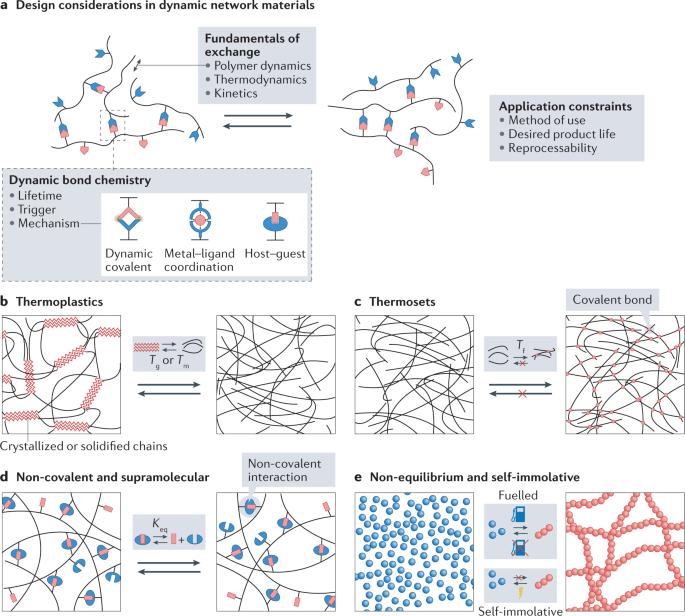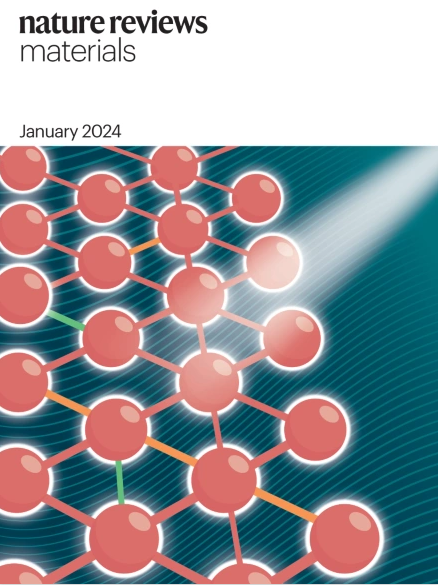Dynamic and reconfigurable materials from reversible network interactions
IF 79.8
1区 材料科学
Q1 MATERIALS SCIENCE, MULTIDISCIPLINARY
引用次数: 53
Abstract
Polymer materials provide solutions to some of the most pressing environmental, manufacturing and health-care challenges. Traditional thermoplastic and thermoset networks, however, have a limited capacity to reconfigure and restructure, and fail to match the dynamics required for many applications. Introducing dynamic bonding interactions into polymer networks can produce materials that are more easily processed, applied and recycled than their static counterparts. In this Review, we highlight an array of polymer materials designed with dynamic bonds and reconfigurable networks, and discuss the different classes of molecular-scale motifs used to realize dynamic behaviour. After surveying the fundamental polymer physics governing dynamic networks, we examine the many ways to engineer the time regimes of dynamic materials to suit particular applications. Finally, we conclude by discussing opportunities to further develop and integrate these dynamic concepts into existing processes and applications of polymer materials. Polymer materials that can reorganize over time or under specific conditions have enormous advantages over static polymer networks. This Review discusses the many classes of molecular bonding motifs used to introduce dynamicity to polymer materials and outlines the design rules for engineering the interaction timescales for desired applications.

动态和可重构材料从可逆网络相互作用
聚合物材料为一些最紧迫的环境、制造和医疗挑战提供了解决方案。然而,传统的热塑性和热固性网络的重构和重组能力有限,无法满足许多应用所需的动态性。将动态键合相互作用引入聚合物网络,可以生产出比静态材料更易于加工、应用和回收的材料。在本综述中,我们将重点介绍一系列采用动态键和可重构网络设计的聚合物材料,并讨论用于实现动态行为的各类分子尺度图案。在概述了支配动态网络的基本聚合物物理学之后,我们研究了设计动态材料的时间状态以适应特定应用的多种方法。最后,我们讨论了进一步发展这些动态概念并将其融入聚合物材料现有工艺和应用的机会。与静态聚合物网络相比,可随时间或在特定条件下重组的聚合物材料具有巨大优势。本综述讨论了许多用于为聚合物材料引入动态性的分子键动机类别,并概述了为所需应用而设计相互作用时间尺度的设计规则。
本文章由计算机程序翻译,如有差异,请以英文原文为准。
求助全文
约1分钟内获得全文
求助全文
来源期刊

Nature Reviews Materials
Materials Science-Biomaterials
CiteScore
119.40
自引率
0.40%
发文量
107
期刊介绍:
Nature Reviews Materials is an online-only journal that is published weekly. It covers a wide range of scientific disciplines within materials science. The journal includes Reviews, Perspectives, and Comments.
Nature Reviews Materials focuses on various aspects of materials science, including the making, measuring, modelling, and manufacturing of materials. It examines the entire process of materials science, from laboratory discovery to the development of functional devices.
 求助内容:
求助内容: 应助结果提醒方式:
应助结果提醒方式:


